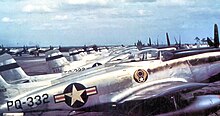
Buzz numbers were letter-number combinations displayed by United States Air Force military aircraft in the years immediately after World War II, through the early 1960s.
Contents
The first two letters of a buzz number indicated the type and designation of an aircraft while the last three were generally the last three digits of the aircraft serial number. Air Force fighters used buzz numbers starting with the letter F (or P, when fighters were designated as "pursuit" aircraft before June 1948), while bombers started with the letter B. For example, a P-51 Mustang would have a buzz number such as FF-230 while an F-86 Sabre might be FU-910. A B-66 Destroyer would have a buzz number such as BB-222. One of the last Air Force fighters to carry a buzz number was the F-4 Phantom II (FJ), then called the F-110 Spectre by the Air Force.


